
How do you prepare a person for an experience like no other? An experience so extreme and out of this world that not having accurate pre-exposure would vastly limit their knowledge and potentially threaten their safety? It’s no wonder the immersive, visual and sound-based experience of Virtual Reality (VR) and eXtended Reality (XR) is being adopted for preparation and training; especially when it comes to performing unique tasks in unusual environments. For example, Boeing’s mechanics and engineers use VR training to practice installing and assembling landing gear in new aircrafts. The XR experience allows workers to identify flaws in the production system which reduces mistakes in real life and any associated costs. Additionally, some militaries have adopted the use of XR in training so they can expose soldiers to a variety of situations ahead of combat without putting them at risk.
Given its extended advantages, it’s not surprising to learn that more and more companies are using VR. But did you know NASA has been using the technology since the early nineties? For several decades, VR has served as an important testbed for developing tools and techniques for space exploration. Let’s review some of the ways NASA has been using VR, and what’s needed to train and prepare for destinations like Mars.
How NASA uses VR
Before qualifying for an assignment in space, NASA’s astronaut candidates need to go through multiple years of training. This includes learning to work in a simulated space environment. Luckily, XR presents a unique opportunity to easily access scenarios at a manageable cost. For example, the Virtual Reality Lab at NASA Johnson Space Center is where astronauts do virtual training on the use of the Simplified Aid For EVA Rescue (SAFER). Thanks to real time graphics and motion simulators integrated with a robotic device, astronauts are able to feel the kinesthetic sensation of an object they may use when conducting repair work on the ISS or elsewhere. Doing simulated work ahead of time gives astronauts insight into what they can expect once deployed.
VR is also being used to help engineers design spacecraft instruments and test out repair processes before they start to build or repair anything. Working out problems virtually before moving to the physical model makes for more efficient and cost-effective design, build, and repair time.
Using VR to train for Mars
While a lot of time is required to prepare for a mission to space or the Moon, preparing for a mission to Mars is next level. In 2020, NASA sent a rover dubbed Perseverance to Mars in order to collect samples and send back information to Earth. For over a year, Perseverance has been capturing 360-degree panoramic images of the red planet’s environment and these images, when combined with a technology called copernic360, let people virtually walk on the surface and experience the Martian environment for themselves. But this is just the beginning of the virtual scenarios needed to help astronauts learn and prepare for life on Mars.
NASA is currently developing an XR exploration surface analog known as, “Assessments of Physiology And Cognition in Hybrid-reality Environments” (APACHE). The goal of APACHE is to create a planetary exploration EVA scenario environment that provides a representative physical and cognitive workload approximation using a combination of virtual reality (XR), physical reality, and hybrid reality (HR) techniques.
If creating realistic VR simulations that enable NASA researchers, test subjects, and potentially astronauts with the experience they need to survive beyond their home planet interests you, then check out the NASA MarsXR Challenge. NASA is seeking developers to create assets focused on particular extravehicular activities (EVA) scenarios that will be used to test procedures and plan for conditions while on Mars. Don’t delay! Winning submissions could serve an important role in future astronaut training and exploration.








